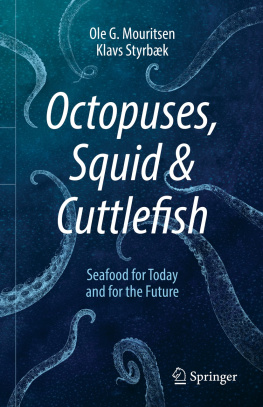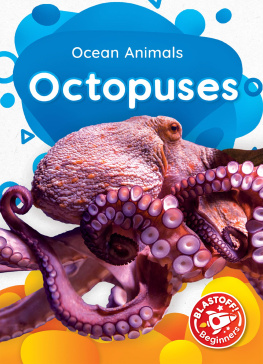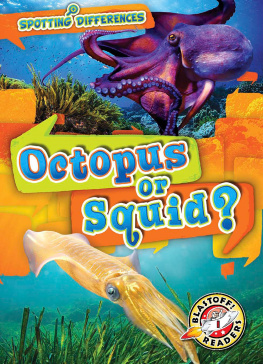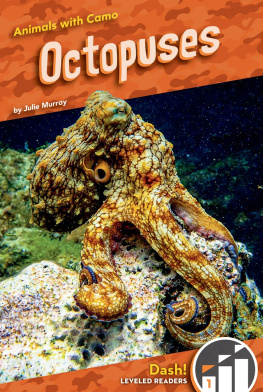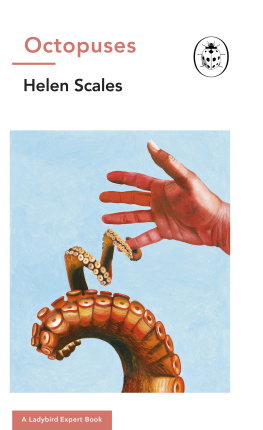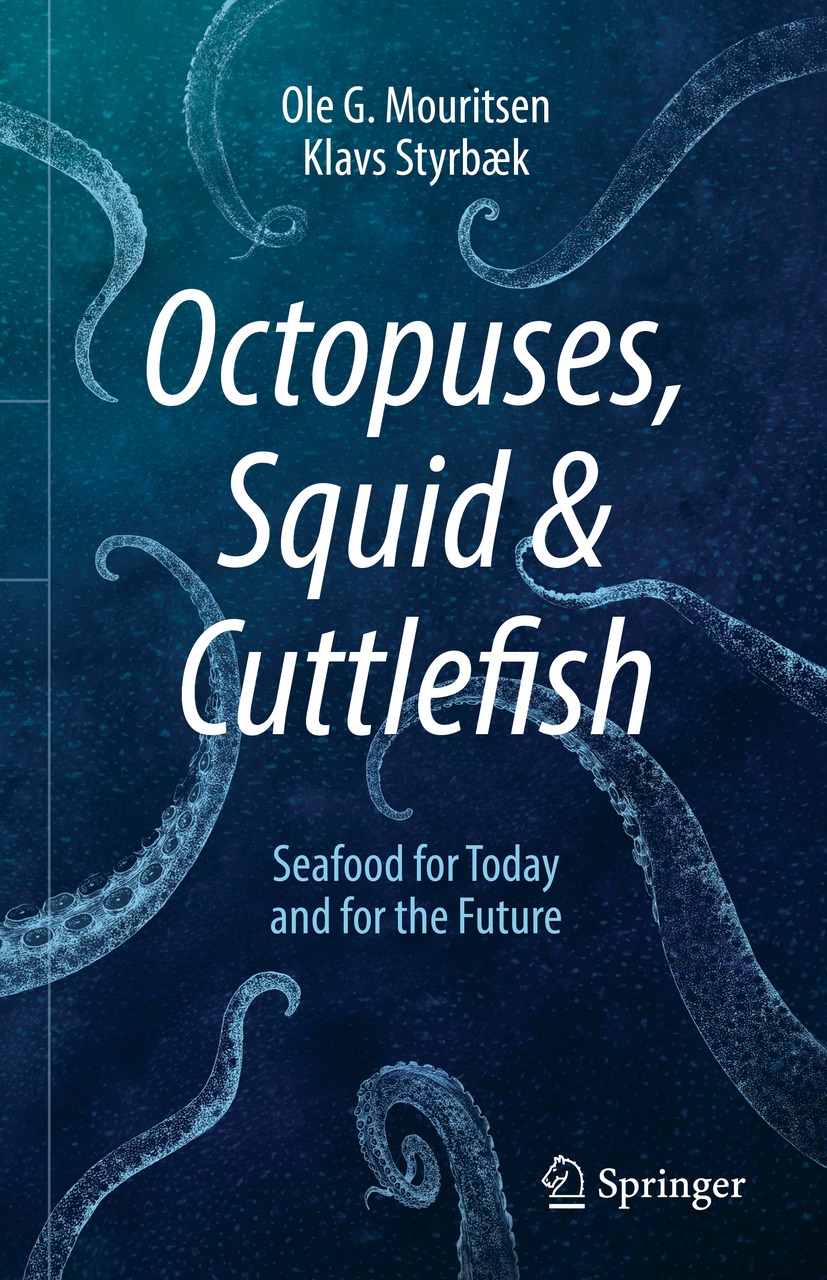Ole G. Mouritsen and Klavs Styrbk
Octopuses, Squid & Cuttlefish
Seafood for Today and for the Future
1st ed. 2021
Translation and adaptation to English by Mariela Johansen
Photography by Jonas Drotner Mouritsen

Logo of the publisher
Ole G. Mouritsen
Department of Food Science, University of Copenhagen, Copenhagen, Denmark
Klavs Styrbk
STYRBKS, Odense N, Denmark
ISBN 978-3-030-58026-1 e-ISBN 978-3-030-58027-8
https://doi.org/10.1007/978-3-030-58027-8
Translation from the language edition: by Ole G. Mouritsen, and Klavs Styrbk, 0. Published by . All Rights Reserved.
The Editor(s) (if applicable) and The Author(s), under exclusive license to Springer Nature Switzerland AG 2018, 2021
This work is subject to copyright. All rights are solely and exclusively licensed by the Publisher, whether the whole or part of the material is concerned, specifically the rights of translation, reprinting, reuse of illustrations, recitation, broadcasting, reproduction on microfilms or in any other physical way, and transmission or information storage and retrieval, electronic adaptation, computer software, or by similar or dissimilar methodology now known or hereafter developed.
The use of general descriptive names, registered names, trademarks, service marks, etc. in this publication does not imply, even in the absence of a specific statement, that such names are exempt from the relevant protective laws and regulations and therefore free for general use.
The publisher, the authors and the editors are safe to assume that the advice and information in this book are believed to be true and accurate at the date of publication. Neither the publisher nor the authors or the editors give a warranty, expressed or implied, with respect to the material contained herein or for any errors or omissions that may have been made. The publisher remains neutral with regard to jurisdictional claims in published maps and institutional affiliations.
This Springer imprint is published by the registered company Springer Nature Switzerland AG
The registered company address is: Gewerbestrasse 11, 6330 Cham, Switzerland
Acknowledgements
In our work on this project we have been helped and guided by a long list of colleagues and good contacts. We are particularly indebted to:
The members of the The Squid Squad at Nordic Food Lab Louise Beck Brnnum, Charlotte Vinther Schmidt, Yi-Ting Sun, Peter Lionet Faxholm, Roberto Flore, and Karsten Olsen. Special thanks are due to: Karsten Olsen, who enthusiastically and imaginatively engaged himself in gatrophysical and gastronomic studies of Danish squid; Roberto Flore, who arranged a field trip to Sardinia to see how cephalopods are caught and to sample how they are used in local gastronomic specialties; Peter Lionet Faxholm, who sorted out taxonomic relationships, reviewed the manuscript thoroughly, and made valuable comments on it.
Co-workers at Taste for Life for inspiration and joint work on cephalopod taste.
Mathias Porsmose Clausen, University of Southern Denmark, for microscopy of cephalopod muscle structure.
Prof. Anna Di Cosmo and Prof. Gianluca Polese, Universit degli Studi di Napoli Federico II, for discussions about octopuses and their nervous system, as well as the necessity to exploit marine resources more sustainably.
Dr. Graziano Fiorito, Stazione Zoologica Anton Dohrn, Naples, for informative discussions about Cephalopoda, especially concerning the behavioural biology of octopuses and the significance of implementing rules for the treatment of cephalopods, and also for the present of his impressive book on pattern formation in cephalopods.
Dr. Pamela Imperadore, Stazione Zoologica Anton Dohrn, Naples, for a tour of the laboratories with the octopus aquaria, as well as insightful explanations about the animals behaviour, their nervous systems, and their ability to regenerate them if damaged.
Dr. Xavier Bailly, Station Biologique de Roscoff in Brittany, for a tour of the institution and an explanation of his laboratory model for aquaculture of Sepia officinalis, which has enabled him to raise cuttlefish through a complete life cycle, from eggs to adults.
Prof. Jos Lucas Prez Llorns, Cdiz, for information about Andalusian pescato frito made with cephalopod meat and for arranging contacts with Spanish cephalopod researchers.
Dr. Ling Miao for information about the Chinese expression for deep-fried squid.
Captain Ignaco Lpez Cabrera (Cofrada de Pescadores de Motril), Abdelaziz Shabi (Grupo de Pesca Costa Granada), and biologist Inmaculada (Inma) Carrasco Rosada for arranging a fishing trip on a trawler along the coast near Motril and Almucar in Southern Spain. Special thanks to Inma for information about species designations for cephalopods and fish.
Head chef Yoshinori Ishii (Restaurant Umu, London) and Sakiko Nishihara for conversations about Japanese ways of preparing cephalopods.
Poul Rasmussen, Albanifisk, for supplying fresh cephalopods from the North Sea.
Dr. Paul John Frandsen for carefully identifying the images of cephalopods in the Punt reliefs.
Prof. Masayoshi Ishida, Ritsumeikan University, Japan, for the outstanding gift of surume, traditional dried Japanese flying squid.
Mette Holm for references to cephalopods in Japanese cuisine.
Jens Peter Henriksen for bringing back fresh cephalopods from Malaga in this hand luggage.
Rikke Hjer for making an imprint, gyotaku, using a Danish squid.
Prof. Paw Dalgaard for information and literature concerning the risks associated with eating cephalopods.
Mads Friis Nielsen and Restaurant mmoks for lending serving plates for food photography.
Steen Aalund Olsen for the loan of a belemnite.
Kristoff Styrbk for several of the pictures of food included in the book.
Chef Kasper Styrbk for participating in the development of cephalopod recipes and dishes.
This book first took shape when one of us (Ole) had a grant that allowed him to spend some productive writing time in May 2017 at the thousand-year-old monastery of the San Cataldo Institution. Its peaceful atmosphere, together with its surroundings on the Amalfi coast of southern Italy, a UNESCO World Heritage site of immense natural beauty and many architectural and art treasures, provided the perfect framework for delving into the strange and fascinating world of the cephalopods and, especially, their culinary uses. At this point Klavs had already, over a period of years, experimented with preparing cephalopods in his professional kitchen at STYRBKS.
In addition, this book draws on a wide range of scholarly articles and scientific literature. Many individuals and organizations have generously made photographs, images, and other illustrative materials available for use in this book. See Bibliography and Illustration Credits.
Jonas Drotner Mouritsen has participated in the production of this book from its inception and has taken many of the photographs.

